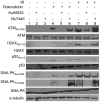Targeting the DNA double strand break repair machinery in prostate cancer
- PMID: 21629734
- PMCID: PMC3100351
- DOI: 10.1371/journal.pone.0020311
Targeting the DNA double strand break repair machinery in prostate cancer
Abstract
Regardless of the achievable remissions with first line hormone therapy in patients with prostate cancer (CaP), the disease escapes the hormone dependent stage to a more aggressive status where chemotherapy is the only effective treatment and no treatment is curative. This makes it very important to identify new targets that can improve the outcome of treatment. ATM and DNA-PK are the two kinases responsible for signalling and repairing double strand breaks (DSB). Thus, both kinases are pertinent targets in CaP treatment to enhance the activity of the numerous DNA DSB inducing agents used in CaP treatment such as ionizing radiation (IR). Colony formation assay was used to assess the sensitivity of hormone dependent, p53 wt (LNCaP) and hormone independent p53 mutant (PC3) CaP cell lines to the cytotoxic effect of IR and Doxorubicin in the presence or absence of Ku55933 and NU7441 which are small molecule inhibitors of ATM and DNA-PK, respectively. Flow cytometry based methods were used to assess the effect of the two inhibitors on cell cycle, apoptosis and H2AX foci formation. Neutral comet assay was used to assess the induction of DNA DSBs. Ku55933 or NU7441 alone increased the sensitivity of CaP cell lines to the DNA damaging agents, however combining both inhibitors together resulted in further enhancement of sensitivity. The cell cycle profile of both cell lines was altered with increased cell death, DNA DSBs and H2AX foci formation. This study justifies further evaluation of the ATM and DNA-PK inhibitors for clinical application in CaP patients. Additionally, the augmented effect resulting from combining both inhibitors may have a significant implication for the treatment of CaP patients who have a defect in one of the two DSB repair pathways.
Conflict of interest statement
Figures




References
-
- Denis LJ, Griffiths K. Endocrine treatment in prostate cancer. Semin Surg Oncol. 2000;18:52–74. - PubMed
-
- Melia J. Part 1: The burden of prostate cancer, its natural history, information on the outcome of screening and estimates of ad hoc screening with particular reference to England and Wales. BJU Int. 2005;95(Suppl 3):4–15. - PubMed
-
- Khanna KK, Lavin MF, Jackson SP, Mulhern TD. ATM, a central controller of cellular responses to DNA damage. Cell Death Differ. 2001;8:1052–65. - PubMed
-
- Jackson SP. Sensing and repairing DNA double-strand breaks. Carcinogenesis. 2002;23:687–96. - PubMed
-
- Kanaar R, Hoeijmakers JH, van Gent DC. Molecular mechanisms of DNA double strand break repair. Trends Cell Biol. 1998;8:483–9. - PubMed
Publication types
MeSH terms
Substances
Grants and funding
LinkOut - more resources
Full Text Sources
Other Literature Sources
Medical
Research Materials
Miscellaneous

